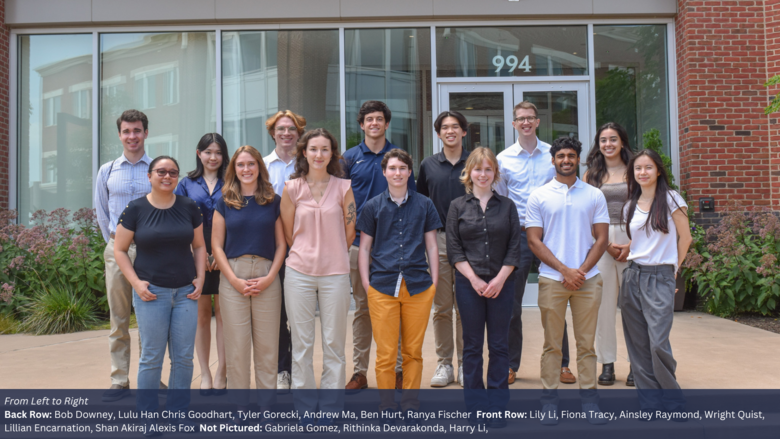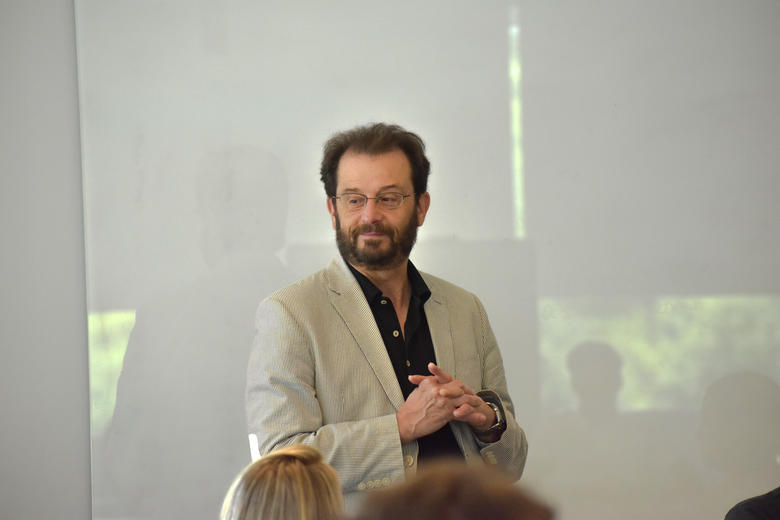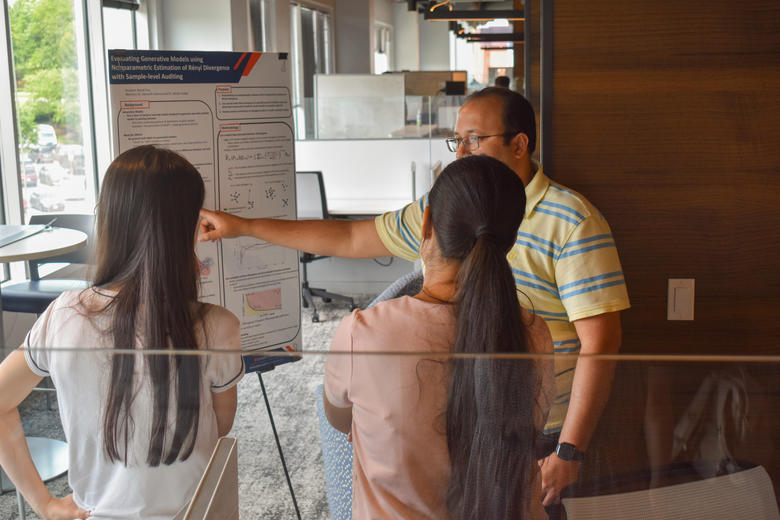
Computing for Global Challenges Symposium Highlights Students' Efforts in Tackling Global Challenges
Excitement filled the air at the 2023 Computing for Global Challenges (C4GC) Symposium on Thursday, July 27th. Over the span of eight weeks, students representing diverse collegiate institutions worked with mentors from the Biocomplexity Institute (BI) on projects embracing real-world challenges and questions. Hailing from universities such as UVA, Cornell, and even Charlottesville High School, the group demonstrated its commitment to exploring solutions for pressing issues from politics to healthcare and environmental stability.
The C4GC program, organized by BI’s Network Systems Science and Advanced Computing (NSSAC) division, emphasizes team science as students work with both their peers and various scientists within the division. Students learned new ways to address real-world concerns during the program while working on their research projects.
Initially launched in 2019 as a 10-week program, the C4GC initiative has since evolved and changed under the influence of the NSSAC team. It now spans eight intense weeks during the summer. However, the program’s core focus of addressing prominent real-world issues has remained steadfast, and the topics of interest have endured similarly. The projects taken on by students focused on major, systemic, and global topics of interest, such as disaster resilience and preparedness, epidemic forecasting, and best agricultural practices.
The 2023 symposium commenced with a few welcome remarks from Data Scientist, Ben Hurt, who oversaw the C4GC program this year. Also, Dr. Madhav Marathe, Division Director of NSSAC, extended words of welcome and encouragement to the students before their presentations.

The 2023 cohort of C4GC students included sixteen exceptional individuals: Tyler Gorecki, Ainsley Raymond, Chris Goodhart, Andrew Ma, Alexis Fox, Lulu Han, Ranya Fischer, Shan Akiraj, Fiona Tracy, Lillian Encarnation, Bob Downey, Gabriela Gomez, Rithika Devarakonda, Harry Li, and Wright Quist. These participants showed off their hard work and studious efforts to a captivated audience at the culminating symposium, which ran from 10 am until 12 pm.
Tyler Gorecki, a UVA Student, initiated the presentations with his project entitled, "Analyzing the Role of Virginia Healthcare Facilities in the Spread of Methicillin-resistant Staphylococcus aureus (MRSA)." Gorecki's main question pondered if medical researchers and scientists can understand the spread of antimicrobial-resistant (AMR) infections such as MRSA within healthcare settings. Given that MRSA and similar AMR infections are deemed a top 10 global health threat by the WHO and are, unfortunately, a common occurrence in healthcare settings, Gorecki chose to study only its spread in Virginia healthcare facilities from 2016-2017. He hopes that cases can be investigated more regularly in the future, with even weekly case counts conducted so that all data collected will be up to date.
Ainsley Raymond, a student from Cornell, presented her project, "A Decision Support Model for Tailored Public Transportation Restriction Strategies in an Epidemic," on the impacts of the COVID-19 pandemic on public transportation usage in the city of Ithaca, New York. Her findings concluded that pandemic fears, along with stay-at-home orders, resulted in a drop in the use of public transportation. This caused two concurrent financial issues- first, reduced usage led to profit losses for transportation companies, and jobs were lost as fewer busses were needed. Second, with fewer buses running and fewer drivers hired, transportation reliability plummeted, and the infrequency created difficulties for socially vulnerable populations such as people experiencing homelessness and older people. Raymond's research revealed that the total service reduction resulting from pandemic revenue losses was 20%. This was a significant blow for a community with a high bus-usage rate. Raymond expressed that she was very interested in continuing her research on this topic because the city of Ithaca and the people there are important to her as it is where she goes to college.
Similarly, UVA student Harry Li studied the consequences of unforeseen circumstances on a widely used institution on the public. Li’s project, “Evaluating the Impact of Bailout Strategies on Financial Networks,” analyzed the fallout resulting from financial contagion disruptions on public networks, explicitly focusing on banks. When banks owe each other, and one defaults, it creates disorder for all other banks in this payment chain, called a “financial contagion.” Li used the 2008 housing bubble pop as an example, displaying how one issue can swiftly lead to subsequent collapses and defaults for other banks. He hopes that in the future, there will be more exploration beyond just financial contagions with computing models so that other networks, problems, and consequential issues can also be studied.
Other presentations followed various subjects from COVID-19 spread, agriculture and deep learning techniques, water abstraction, virtual community building, and using computational analysis to understand the initiation and subsequent impacts of Guillain-Barre syndrome. Each student discussed the mechanics of their projects, the methods of computation they used, and the results and implications of the data they collected.
 The first half of the C4GC Symposium concluded with a brief reflection from Chris Barrett, Executive Director of the Institute. He recalled conducting the same kind of research as these bright students before the days of the modern internet when data was collected through codes in phonebooks. Barrett congratulated students on their hard work and remarked excitedly on how sophisticated and advanced it was. He continued, saying that as a group, they were one of the best the Biocomplexity Institute and C4GC Program had been privileged to see.
The first half of the C4GC Symposium concluded with a brief reflection from Chris Barrett, Executive Director of the Institute. He recalled conducting the same kind of research as these bright students before the days of the modern internet when data was collected through codes in phonebooks. Barrett congratulated students on their hard work and remarked excitedly on how sophisticated and advanced it was. He continued, saying that as a group, they were one of the best the Biocomplexity Institute and C4GC Program had been privileged to see.
Finally, the symposium concluded with an interactive question-and-answer session open to all attendees. The students presented their posters via ZOOM to participants that joined their breakout room during the last hour of the conference.
 When asked about their favorite parts of the C4GC program and their reason for applying, students' answers were full of anticipation for the future. There was also a consensus of gratitude among the group for what they had learned through their research and mentorships.
When asked about their favorite parts of the C4GC program and their reason for applying, students' answers were full of anticipation for the future. There was also a consensus of gratitude among the group for what they had learned through their research and mentorships.
Ainsley Raymond said that her favorite aspect of the C4GC program was that she was able to experience "an intersection of [her] passions" between public health and real-world issues through data science and computing.
Similarly, Harry Li said he appreciated "being in an environment where learning and making mistakes was encouraged, and where [the scientists] made it fun."
Bob Downey appreciated that he "could take independent direction in the work [he] was doing" and hopes to continue exploring his computer and data science interests, fostered through the C4GC program.
Lillian Encarnation also said she appreciated that she did not have to have an explicitly computational background to submit an application and be accepted into the program. As a student in a parallel field, she applied for the opportunity to do this kind of research because she would like to continue to pursue her project matter after this eight-week course so that she “can make it more niche and focus on genomics” and how it intertwines with epidemic prediction.
Through the C4GC program, students have acquired a new, broadened understanding of computational research methods. Collaborating with mentors and peers, they developed skills to address current, real-life, global issues. Through logic, computation, and a desire to drive positive change, they have gained the necessary tools and experience to start making an impact at their universities, in the US, and beyond.
The Biocomplexity Institute takes pride in hosting and learning from these students through this summer program. Recognizing that today’s youth hold the key to the future, BI aims to nurture their potential and dedication toward improving society. However, fostering the students’ minds, talents, and drive to help others is only one aspect of the goal set forth by C4GC. The other is to become better ourselves by gleaning their relentless efforts to make the world a better place for all people. To the students, the Biocomplexity Institute team says thank you.